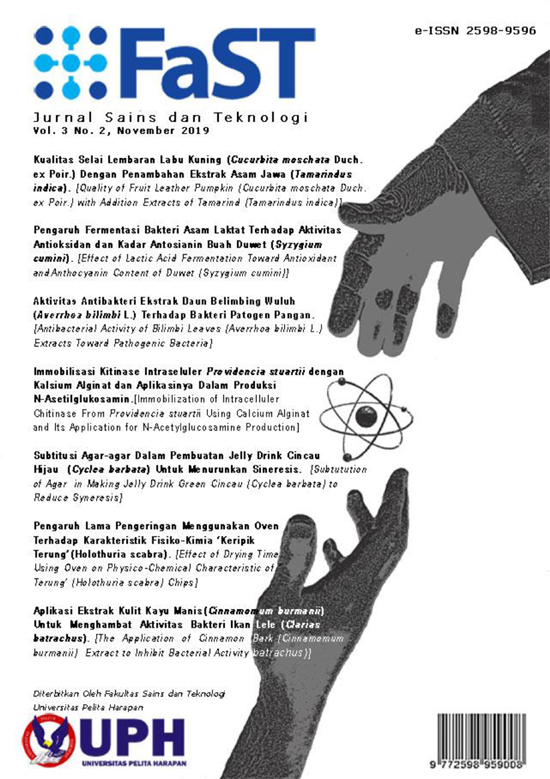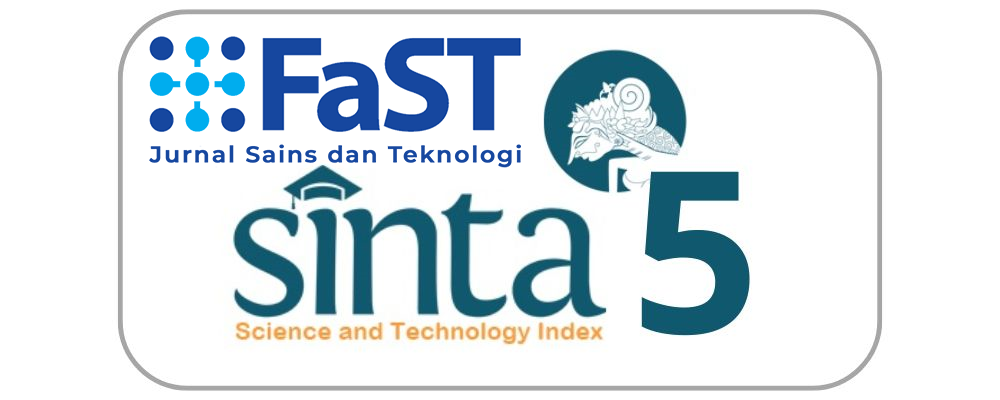PENGARUH LAMA PENGERINGAN MENGGUNAKAN OVEN TERHADAP KARAKTERISTIK FISIKO- KIMIA ”˜KERIPIK TERUNG
Keywords:
chips, drying oven, sea cucumberAbstract
”˜Terung’ (Sea Cucumber) chips, one of the most popular traditional products in Indonesia, are the result of the process of drying sea cucumbers with sunlight and frying. Drying problems arise during the rainy season. The purpose of this study was to determine the effect of drying using an oven temperature of 60oC on the physical and chemical characteristics of sea cucumber chips. The research method used was a long drying experimental method (0 hours, 4 hours, 8 hours, 12 hours) and observational data were analyzed with Anova at a 95% confidence level. The results showed that the drying time treatment significantly affected the water content, protein content, fat content, ash content, swelling power, but did not significantly affect the power of sea cucumber chips. The best drying time is the drying time of 12 hours which produces sea cucumbers chips which are characterized by 58.90% protein content, 1.25% water content, 20.09% fat content, 9.61% ash content, 70.19% swelling power, and 3.85 N/m2power broken.References
Badan Standarisasi Nasional (BSN). 1998. SNI Keripik Ikan (SNI 19-0428-1998). Badan Standarisasi Nasional (BSN). Jakarta. 4 hal. Ernawati, A. T. D dan Aniek, W. 2013. Uji Kimia keripik kulit Ikan Patin (Pangasius pangasius) dengan perbedaan perlakuan suhu perendaman. Jurnal Fakultas Teknologi Pertanian Unwidha Klaten. 15(83): 22-31. Gilnatya, N. 2002. Pemanfaatan kulit tuna mata besar (Thunnus obesus) sebagai bahan baku kerupuk kulit. Bogor : Skripsi FPIK Institut Pertanian Bogor. Kustiariyah. 2007. Teripang sebagai sumber pangan dan bioaktif. Buletin Teknologi Hasil Perikanan. 10(1):1-8. Kusumaningrum, I. dan Andi N.A. 2016. Karakteristik keripik ikan fortifikasi kalsium dari tulang Ikan Belida. Jurnal Pengolahan Hasil Perikanan Indonesia. 19(3):233-240. Martoyo J, Aji N, dan Winanto T. 2000. Budidaya Teripang. Jakarta: Penebar Swadaya. 69 hlm. Muliawan, D. 1991. Pengaruh berbagai tingkat kadar air terhadap pengembangan keripik sagu goreng. Bogor : Skripsi Jurusan Teknologi Pangan dan Gizi. Fakultas Teknologi Pertanian IPB. Mulyana, Wahono H.S. dan Indria P. 2014. Pengaruh proporsi (Tepung Tempe Semangit : Tepung Tapioka) dan penambahan air terhadap karakteristik keripik tempe semangit. Jurnal Pangan dan Agroindustri. 2(4): 113-120. Nurwahyuningsih, V. 2010. Pemanfaatan air rebusan ikan Tongkol (Euthynnus affinis) sebagai bahan pembuatan kerupuk. Bogor : Skripsi Departemen Teknologi Hasil Perairan, Fakultas Perikanan dan Ilmu Kelautan, IPB. Putra, T.P., Sri, S., dan Endang, D. 2014. Pengaruh substrat dasar yang berbeda pada sistem resirkulasi terhadap fisiologis Teripang lokal (Phyllophorus Sp.) selama masa adaptasi. Jurnal Ilmiah Perikanan dan Kelautan. 6(2):179-185. Rahmat, B. 1999. Pendugaan umur simpan keripik kulit goreng. Bogor : Skripsi. Fakultas Teknologi Pertanian. Institut Pertanian Bogor. Rosiani, N., Basito, dan Widowati, E. 2015. Kajian karakteristik sensorik fisik dan kimia kerupuk fortifikasi daging lidah buaya (Aloe vera) dengan metode pemanggangan menggunakan microwave. Jurnal Teknologi Hasil Pertanian, 8 (2): 84-98. Salamah E, Susanti M.R., dan Purwaningsih, S. 2008. Diversifikasi kerupuk opak dengan penambahan daging ikan layur (Trichiurus sp.). Buletin Teknologi Hasil Perikanan, 9 (1): 53-64. Setiawan, D. W., Titik D. S dan Eddy S. 2013. Pemanfaatan residu daging Ikan Gabus (Ophiocephalus striatus) dalam pembuatan keripik ikan beralbumin. THPi Student Journal. Universitas Brawijaya. 1(1): 21-32. Susilawati, Dianasari, dan W.N. Jannah. 2017. Pemberdayaan UMKM kelompok usaha kerupuk kulit Ikan Pari di Kabupaten Cirebon untuk meningkatkan nilai tambah ekonomi produk. The 5th Urecol Proceeding, UAD, Yogyakarta. Syarief, R., S. Santausa, dan B. Isyana. 1989. Buku dan Monograf Teknologi Pengemasan Pangan. Bogor : Laboratorium Rekayasa Proses Pangan. PAU Pangan dan Gizi. IPB. Winangsih, Erma P. dan Sarjana P. 2013. Pengaruh metode pengeringan terhadap kualitas simplisia Lempuyang Wangi (Zingiber Aromaticum L.). Buletin Anatomi dan Fisiologi.21(1):19:25. Zulfahmi, A.N., Swastawati, F., dan Romadhon. 2014. Pemanfaatan daging ikan tenggiri (Scrombemorus commerson) kerupuk berbahan dasr sagu dengan substitusi dan fortifikasi rumput laut. Jurnal Ilmiah Perikanan dan Kelautan, 2 (4): 174-179
Downloads
Published
Issue
Section
License
“Authors who publish with this journal agree to the following terms:
1) Authors retain copyright and grant the journal right of first publication with the work simultaneously licensed under a Creative Commons Attribution License (CC-BY-SA 4.0) that allows others to share the work with an acknowledgement of the work's authorship and initial publication in this journal.
2) Authors are able to enter into separate, additional contractual arrangements for the non-exclusive distribution of the journal's published version of the work (e.g., post it to an institutional repository or publish it in a book), with an acknowledgement of its initial publication in this journal.
3) Authors are permitted and encouraged to post their work online (e.g., in institutional repositories or on their website). The final published PDF should be used and bibliographic details that credit the publication in this journal should be included.”



